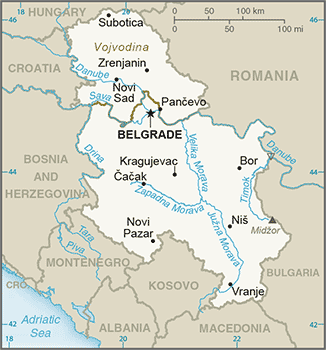|
Serbia
|

|
Capital: Belgrade
Population: 8,772,235
Brief History of Serbia:
Serbia was first inhabited by peoples such as the Thracians, Dacians, and Illyrians. Alexander the Great's Empire entered into the south of Serbia in the 4th century BC. Later Serbia would become part of the Roman Empire. One of the most famous Roman Emperors, Constantine I, was born in Serbia. He brought Christianity to Rome.
The Kingdom of Serbia was founded in 1170 AD by Stefan Nemanja. Later, King Milutin would expand Serbia's territory and the Kingdom would reach its zenith under the power of his son, King Stefan Dusan. However, in the 1400s the Serbians were conquered by the Ottoman Empire.
After well over 300 years of rule by the Ottoman Empire, the Serbians began to fight for independence. Two heroes of the independence movement were Petrovic and Obrenovic. In 1876 Serbia became an independent country per the Congress of Berlin.
During World War I, Serbia was occupied by the Austro-Hungarian army. After the War the Kingdom of the Serbs, Croats, and Slovenes was formed and it would later, in 1929, become the country of Yugoslavia. After World War II, Josip Tito Broz took power and Yugoslavia became a communist country. Tito would rule for many years. In 1989 Slobodan Milosevic became president of Serbia. Civil war was waged for years as many countries such as Croatia and Bosnia tried to break away after the fall of the Soviet Union. Tensions are still high today even thought Milosevic has been removed from power and tried for his crimes against humanity.
The Geography of Serbia
Total Size: 88,361 square km
Size Comparison: slightly larger than South Carolina
Geographical Coordinates: 44 00 N, 21 00 E
World Region or Continent: Europe
General Terrain: extremely varied; to the north, rich fertile plains; to the east, limestone ranges and basins; to the southeast, ancient mountains and hills
Geographical Low Point: NA
Geographical High Point: Daravica 2,656 m
Climate: in the north, continental climate (cold winters and hot, humid summers with well distributed rainfall); in other parts, continental and Mediterranean climate (hot, dry summers and autumns and relatively cold winters with heavy snowfall)
Major cities: BELGRADE (capital) 1.115 million (2009), Novi Sad
The People of Serbia
Type of Government: republic
Languages Spoken: Serbian (official nationwide); Romanian, Hungarian, Slovak, Ukrainian, and Croatian (all official in Vojvodina); Albanian (official in Kosovo)
Independence: 5 June 2006 (from Serbia and Montenegro)
National Holiday: National Day, 27 April
Nationality: Serb(s)
Religions: Serbian Orthodox, Muslim, Roman Catholic, Protestant
National Symbol: double-headed eagle
National Anthem or Song: Boze pravde (God of Justice)
Economy of Serbia
Major Industries: sugar, agricultural machinery, electrical and communication equipment, paper and pulp, lead, transportation equipment
Agricultural Products: wheat, maize, sugar beets, sunflower, beef, pork, milk
Natural Resources: oil, gas, coal, iron ore, copper, lead, zinc, antimony, chromite, nickel, gold, silver, magnesium, pyrite, limestone, marble, salt, arable land
Major Exports: manufactured goods, food and live animals, machinery and transport equipment
Major Imports:
Currency: new Yugoslav dinar (YUM); note - in Kosovo both the euro and the Yugoslav dinar are legal
National GDP: $78,750,000,000
** Source for population (2012 est.) and GDP (2011 est.) is CIA World Factbook.
Back to Geography Home Page
